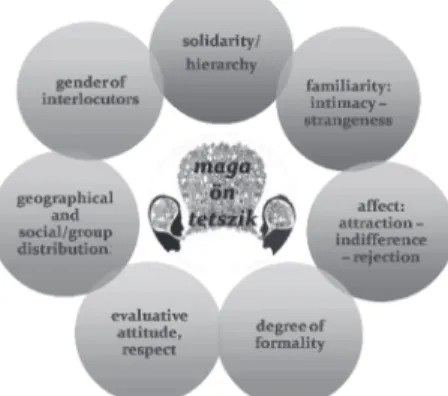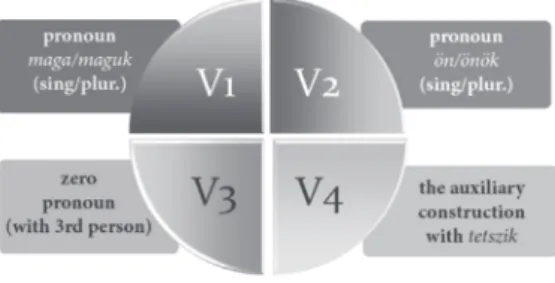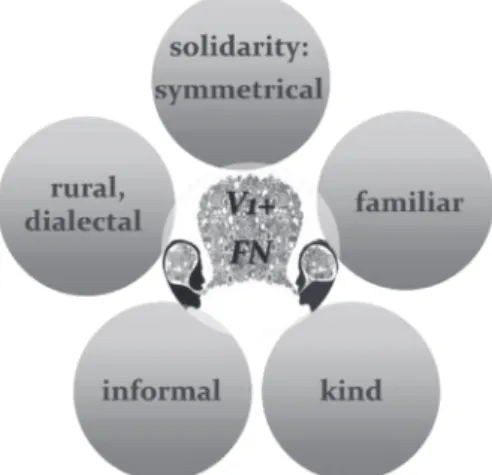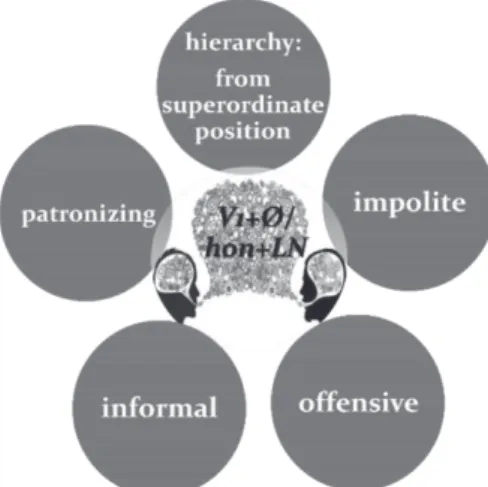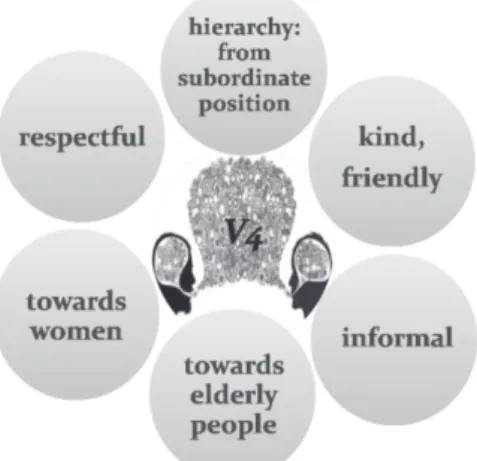Ágnes Domonkosi
abstract
The goal of this paper is to present and interpret the sociocultural value of Hungarian V pronouns and related devices on the basis of speakers’ metapragmatic evaluations.
In addition to the binary division between T and V forms, V is further differentiated in Hungarian: there is a choice of pronoun (maga (V1) vs. ön (V2) – each co-occurring with 3rd person possessives and verbs), as well as a choice of these vs. zero pronoun (with 3rd person) (V3) vs. the structure involving tetszik (V4). Each of these variants has its characteristic sphere of use, social deictic role and stylistic value.
Metapragmatic reflections suggest that according to informants, V forms are also well-suited to signalling degree of formality; the speaker’s evaluative attitude to her addressee, including respect; super- or subordinate status; degree of social proxim- ity; processes of involvement with the increase or decrease of emotional distance;
gender, age and social status of interlocutors.
Key words: address forms; T and V forms; sociocultural value; metapragmatic eval- uation
Subject-affiliation in New cEEoL: Language and Literature – Applied Linguistics – Sociolinguistics
1. introduction. t and V forms of address
Forms of address, i.e. linguistic markers of the addressee (nominal or pronomi- nal forms as well as inflectional morphemes, cf. Domonkosi 2002, 4) are the most direct linguistic means available for indicating the relationship between discourse participants. Thus, they make a key contribution to the linguistic construal of social reality.
By default, languages use second person singular forms to refer to the address- ee of a message. However, some languages allow shifts in the use of grammatical person and number, with the discourse partner possibly referred to by second person plural, third person singular or plural, or even first person plural (cf. Head 1978, Helmbrecht 2003). Early studies in sociolinguistics, based primarily on the bipartite system of European languages, attributed specific social value to this grammatical differentiation. In their classical analysis, Brown and Gilman (1960, 253–276) interpreted the differentiation of forms of address as reflecting the se- mantics of power and solidarity. Under the proposal, primary second person forms
1 The research reported here was supported by the Bolyai János Research Scholarship.
(T-forms) generally indicate proximity, solidarity, equality and intimacy, whereas chronologically secondary V-forms signal distance, power, an asymmetrical rela- tionship and respect.
The present paper discusses ways of maintaining social contact by 3rd person forms, and the social or sociocultural value of V in Hungarian. Despite the dichoto- mies inherent in grammatical number and the corresponding separation between T and V,2 the repertoire of Hungarian forms of address cannot be interpreted as a simple binary system. Rather, it involves a dynamic model encompassing a variety of devices with subtly different social meanings, whose functioning is shaped by a range of social, relational and situational factors. Therefore, variability and change in Hungarian addressing conventions can only receive a thorough analysis when the varieties are not merely situated with respect to T and V, but rather described in conjunction with the associated pronominal and nominal devices (or lack thereof), at the level of schemas underlying the speaker’s choice of construal.
2. the goals and methods of analysis
The goal of this paper is to explore what typical social deictic values are attached to particular varieties of V, and how the various forms of address are related to each other. The analysis is based on the assumption that the use of V forms depends on a highly complex system of relationships, with certain forms of address character- ized by conflicting social value attributions. I will argue that the sociocultural value of particular devices necessitates the use of a range of criteria, and that speakers’
metapragmatic reflections may aid the modelling of social meanings, schematic sociocultural values.
The data informing my interpretations, giving rise to a comprehensive model, are supplied by earlier empirical investigations (Domonkosi 2002, 2010, 2016, Domonkosi–Kuna 2015, 2016). In addition, I also rely on more recent research results; specifically, the material of nine interviews and three focus group con- versations. Moreover, non-systematic surveys of opinion have also contributed to the proposed interpretation of social meaning. In particular, I have collected and analysed speakers’ metapragmatic reflections on address forms shared on social media sites and internet forums. Of the results gained by various data collecting methods, I have focused on those which report on speakers’ beliefs and value attributions. The answers received to closed questions of the questionnaires were usefully supplemented by data gained by open questions, interviews, conversa- tions and spontaneous expressions of opinion. Collectively, these data support a comprehensive account of speaker attitudes to the forms of address under study.
In sociolinguistic interpretations of the social meanings of forms of address, traditional accounts focused on the dimensions of power and solidarity (Brown–
Gilman 1960). However, more recent analyses have foregrounded novel criteria as well. Exploring the functioning of forms of address, Clyne, Norby and Warren
2 Markers of a binary differentiation in references to the addressee, based on the French personal pronouns tu and vous, following the classical study of Brown and Gilman (1960). In terms of value attributions, T forms are typically considered more intimate, whereas V forms are more detached or more official.
(2009, 29–30) also rely on Svennevig’s model of the dimensions of social dis- tance. The latter approach interprets social distance as a multi-dimensional phe- nomenon shaped jointly by the dimensions of solidarity, familiarity and affect (Sven- nevig 1999, 33–35). The utility of this model for interpreting forms of address derives primarily from the fact that while all three factors have a scalar structure, their relevance in construing particular situations may vary (Clyne–Norrby–Warren 2009, 28). In this interpretation of the varied functions and socio-cultural roles of Hungarian forms of address, I therefore take into account the multi-dimensional character of social distance. In previous research, this multidimensional approach was applied to the modelling of social values associated with tetszik as a V con- struction of Hungarian (cf. Domonkosi –Kuna 2015, 2016; Kuna 2016).
The usage distribution of T and V forms is typically traced back to the informal/
formal parameter, which yields a distinction between formal and informal pronom- inal forms of address (Brown–Gilman 1960). However, the variability and use of Hungarian V forms of address suggest that this parameter alone cannot account for the social functions involved, and consequently that models of social meaning must incorporate additional factors as well. At the same time, explorations of the usage and functions of V forms of address may contribute to a better understanding of the socio-cultural factors underlying social meanings.
Besides the concept of formality vs. informality, the relationship between speak- ers and the way that the speech situation is construed have also been studied with regard to the parameters of familiarity, distance, deference, camaraderie and in- volvement (Tannen 1984). Bartha-Hámori (2010), for example, conduct their anal- ysis along the axes of involvement vs. distance, solidarity vs. power, convergence vs. divergence, and directness vs. indirectness.
Speakers’ metapragmatic reflections on forms of address point to the fact that the choice of particular forms may be motivated by a variety of factors. Based on style attributions, interpretations and explanations collected by researchers of this topic, solidary/hierarchy, degree of intimacy/strangeness, emotional attitudes (attraction / indifference/ rejection), degree of formality, respect and evaluative attitudes may all receive expression in this way, with geographical or social background and gender also having an impact on speakers’ choices of construal (Figure 1).
Figure 1: A model of sociocultural factors at work in choices of forms of address
The dimensions identified on the basis of the speakers’ reflections contribute to varying degrees to the use of particular variants, thus constituting a complex, dynamic system for the linguistic construal of social relations.
3. V forms of address
In present-day Hungarian, variability in the construal of social relations is man- ifested among V forms by the use of personal pronouns maga (V1) and ön (V2), third-person verb forms used without such pronominal dependents (V3), and con- structions with the auxiliary tetszik (V4) (Figure 2). Due to the existence of distinct pronominal forms, the variability of V is relatively salient. At least by one group of speakers, the patterns involving maga, ön and tetszik are registered as distinct ways of managing social relations in reports on metapragmatic reflections.
Figure 2: Forms of V
The adoption of various V forms is subject to a high degree of variation in almost every sphere of direct communication. The prevalence of distinct forms in particu- lar situation types suggests that none of the forms is domain-specific; rather, each is associated with a well-circumscribed social meaning.
3.1. the sociocultural value of maga – V
1Patterns with maga are subject to the highest degree of variation when it comes to their stereotypical social deictic value. Perceptions and attitudes vary with gene- rations, communities of practice and geographically alike. From this it follows that these patterns may contribute to the construal of a range of different social rela- tions.
Despite its ubiquity, the pronoun maga was linked to a negative, offensive role by nearly 60 percent of informants in my comprehensive questionnaire-based study, with those under 35 producing a significantly higher proportion. The majo- rity of people in this group only expect maga to occur in particularly offensive situ- ations, even rejecting its occurrence when combined with given names and other nominal elements; moreover, 76 percent report that they never use it (Domonkosi 2002, 152). The ongoing decline of this pronoun’s use can be partly explained by
the fact that it was previously licensed in intimate relationships between equals, and in asymmetrical relations on behalf of the person with higher status. Since by now, the mutual use of T forms has become the norm for younger generations in informal situations, maga no longer has a intimate social deictic value in their value attributions. As a result, the pronoun is now mostly perceived as characteristic of top-down communication in asymmetrical social relations.
In the younger generation, even those speakers tend to avoid maga whose dia- lect only has this V pronoun as a form of address. They use it only in their immediate environment (in the home village) but not in urban or unfamiliar contexts, since they are aware of the multiplicity of social roles associated with the device in question (Domonkosi 2002, 154). It seems to be the case, however, that informants reject this form more when replying to active-method surveys than in their actual linguistic practice. In formal but not honorific or official situations, the pronoun has a relative- ly high frequency.
Combined with a given name, maga may be used reciprocally in intimate situ- ations and in relations of equals; furthermore, the superior person may adopt it in asymmetrical relations. This pattern of use is less present in the language of young- er generations under the age of 35, since T forms have come to predominate in most intimate and/or symmetric relations.
Geographically, the use of maga as honorific, in official situations, combined with role nominals marking social rank also displays significant variation. In the comprehensive questionnaire study, 41 percent of informants living in the country- side produced such data, compared with only 9 percent of urban speakers. Such discrepancies in the perceptions and usage patterns associated with maga reflect fundamental differences in attitudes to rural vernaculars and urban language use, and thus cannot be put down to questions of formality/informality or politeness.
Within the use maga, two schematized social deictic values can be discerned, stemming from a variety of factors including the interactional markers the pronoun combines with, maga’s discourse position (separate vocative, part of a vocative construction, argument of a verb) and community practices.
One characteristic social, sociocultural value is linked to informal situations where T forms are dispreferred. In this use, maga is frequently combined with a given name, and may be partly motivated by dialectal tendencies. This deictic value can be recognized in the following informant reports:
• ha nem tegeződünk, de nem is hivatalos helyzetről van szó; ’when we are not in T terms but the situation isn’t official either’
• népies; a falumban általánosan ezt használják; póriasabb, de engem nem zavar, mert sokkal bizalmasabb, mint az ön; ’rural; this is in general use in my village; it is more rural but I don’t mind this because it is much more intimate than the use of ön’
• csak a közvetlen környezetemben használom, falusi stílus, de abban a környezetben ez van rendben ’I only use it in my immediate environment, this is rural style but in that environment this is fine’.
In the proposed multi-dimensional model of sociocultural values, the pronoun’s
schematized social deictic role is shaped by such factors as a symmetric discursive relation, informality, intimacy, and rural style. In addition, especially when used with given names and nicknames, its jovial, distance-reducing character can be noticed (Figure 3).
Figure 3: A model of the sociocultural value of maga expressing solidarity The second discernible social deictic value of maga is the result of schematiza- tion from the practice of using the pronoun from a superior position. This schematic value is highlighted by the following speaker beliefs and reflections, which were produced in answer to questions about the use of maga in a questionnaire study and in interviews.
• ha felháborodom valamin; ’when I’m appalled at something’
• ha valaki udvariatlan velem; ’when somebody is impolite to me’
• ha valakit meg akarok sérteni; ’when I want to offend someone’
• ha dühös vagyok az illető ismeretlen személyre, és lekezelő akarok lenni;
’when I’m angry with an unfamiliar person and I want to be patronizing’
• nem rajongok érte, veszekedésnél annál inkább használom; ’It’s not my favourite, I use it in quarrels mostly’
• vitatkozás során; ’in disputes’
• elmarasztaláskor vagy nemtetszés kifejezésekor. ’in expressions of re- proach or disapproval’
Hence, one characteristic social function of maga concerns the construal of pat ronizing, offensive attitudes in social relations. This schematized function is mostly linked to occurrences of the pronoun as a separate vocative, or in some highly prominent position. The sociocultural model of using maga in asymmetric, hierarchical relations, often expressing an impolite, offensive or patronizing atti- tude, is shown in Figure 4 below.
Figure 4: A model of the sociocultural value of maga expressing a patronizing attitude
The data suggest that in communities where the tetszik construction is in cur- rency, and where the pronoun ön is less likely to be perceived as distancing, the use of maga is rejected to a greater extent. In other words, when maga is part of a multivariate inventory for expressing V, its schematic social meaning shifts toward the expression of offence.
In addition to the two social deictic values just described, maga also appears to function as a neutral V form in several, especially rural communities of practice.
This pattern of use may have a broader scope than what speakers’ metapragmatic reflections suggest.
3.2. the sociocultural value of using ön – V
2The ön pronoun was created by back formation from the words önmaga ’one- self’, önként ’by one’s own will’ during the language reform period. It first appeared in the work Elaboratior Grammatica Hungarica written by Miklós Révai, its original meaning is ’he/she’ (TESz.). Since it was introduced into the inventory of interac- tional elements in a top-down, artificial manner, it is understandable that it is prima- rily linked to official, impersonal relations.
Informants’ evaluations of ön indicate a complex social value, with its role in expressing politeness supplemented by perceptions of coldness, stiffness, or dis- tance.
• hivatalos, kifejezetten formális ’official, highly formal’
• távolságtartó ’distancing’
• illedelmes ’decent’
• nagyfokú tiszteletet fejez ki ’it expresses great respect’
• udvarias, de távolságtartó ’polite but distancing’
• udvariasabb, mint a maga, de nekem hűvösebb is ’more polite than maga but to me it’s colder too’
• választékos ’sophisticated’
• szebb, kellemesebb, mint a maga ’nicer, more pleasant than maga’
• finomkodó ’delicate’
• felemelő ’uplifting’
• levelezésben és a nyilvánosságban szerintem csak ez a forma képz- elhető el ’in correspondence and in the public sphere only this form is ad- equate’
Despite the high degree of variability found in Hungarian usage patterns of V, the role of ön as a form of address associated with formal communication seems to prevail in the entire speech community. This sociocultural role or social meaning can be modelled as seen in Figure 5 below.
Figure 5: A model of the sociocultural value of ön
Albeit to a smaller extent than with maga, the social value of ön as a form of add- ress may be slightly modified by other forms of address it combines with, with the typical values of such co-occurrences also potentially undergoing schematization.
As an addressing pronoun, ön without nominal elements is particularly well-sui- ted to communication with strangers. Its use is meant to convey not the social rank or position of the addressee but rather to the speaker’s adaptation to the official speech situation (sphere of communication). This function also motivates its use in official documents and radio as well as television broadcasts directed at a larger audience.
Combined with forms of address foregrounding social rank or position, the use of ön is the most widespread addressing strategy in status-marked communicative domains. In such contexts, it is regarded by all age groups as a general form ex- pressing a high degree of respect, formality and politeness.
When co-occurring with given names, the use of ön is linked to intimate situa-
tions where T forms would not be appropriate. This is primarily characteristic of the language of those under 35 years of age; many informants in this age group even regard this form as suitable for addressing colleagues who are not yet on T terms.
The pattern may seem unusual, given the distancing value of ön and the high de- gree of personality implied by the use of given names. However, its use may have evolved precisely as a way of softening the stiffness conveyed by the pronoun.
This variant corresponds to the Sie + given name pattern of present-day German, described by Hickey (2003, 415) as a device for manipulating formality. Moreover, a similar strategy has also been identified in French (Clyne et al. 2009, 43, 155).
3.3. the sociocultural value of pronoun avoidance – V
3As described in the sections above, V pronouns have peculiar social functions and restricted spheres of use resulting from their specific sociocultural values. This may be the main reason behind pronoun avoidance, i.e. the often consciously adopted interactive practice in which 3rd person verbs co-occur only with given names and role nominals but not pronouns.
Especially in the younger generation, pronoun avoidance is part of a broader strategy. Namely, when the speaker knows the addressee, she uses her given name or a role nominal as a way of avoiding the use of pronouns, and when she does not know her, then she resorts to impersonal constructions in domains where status marking is not an issue. These constructions, including patterns with the auxiliary tetszik, allow the speaker to avoid verbally touching the other person.
The conscious behaviour inherent in this strategy is demonstrated by the following self-report by one of the informants.
Én soha nem mondom senkinek azt, hogy maga, mert valahogy az a maga az olyan pórias, olyan közönségesebb. Valahogy olyan durvának tűnik. Az ön meg már nekem túl finom. Tehát a kettő között én szépen elevickélek mind a két szó használata nélkül.
’I never address anyone with maga, because maga is kind of plebeian, kind of coarse. Somehow it feels rough. And then ön feels too genteel to me. So I flounder along between the two, without using either word.’
The high degree of pronoun avoidance and the self-awareness demonstrated by informants suggest that the lack of V pronouns is endowed with social meaning, which consists in the expression of neutral attitude as an alternative to overly formal and possibly offensive options.
3.4. the sociocultural value of tetszik – V
4The tetszik construction involves the auxiliary tetszik, literally meaning ’[it] pleas- es [you]’ and its infinitival complement, as in Hogy tetszik lenni? ’How are you?’
(formal), lit. ’How does it please you to be?’, evolved as a marker of politeness in conjunction with pronominal patterns of V. However, in certain types of social in- teraction, it has come to have an interactive role of its own. The use of tetszik may fulfil various social functions, perceived differently by particular age groups (cf.
Domonkosi–Kuna 2016)
In the language use of children and young speakers, linguistic interactions with tetszik are neatly separated from other V variants. The results of a questionnaire study suggest that speakers under the age of 14 overwhelmingly adopt this form when addressing their teachers and adults they do not know. In fact, some of them completely do without using pronominal V forms of address (cf. Domonkosi 2002).
It is also employed in intimate, personal but not fully equal social relations, espe- cially when there is a big age gap between the interlocutors. In speech directed at elderly people, the tetszik construction may be regarded as dominant in the overall sample as well (Domonkosi 2002).
In the service sector, it is common even among speakers of the same age as an expression of politeness or courtesy. Previous studies found this to be charac- teristic of the language of middle-aged and elderly people (Domonkosi 2002).
More recently, however, it has also gained ground in the urban, pronoun-avoiding language use of younger speakers (Domonkosi–Kuna 2016).
To summarize, the tetszik + infinitive construction may indicate a variety of so- cial relations. Firstly, it is employed in interactions between children and adults.
Secondly, it is commonly used in non-equal but still intimate relations, especially in speech directed at the elderly or at women. Thirdly, as an impersonal construc- tion, it is well-suited to the expression of politeness, especially in questions and requests, in a range of situations which are neither intimate nor status-marked.
Figure 6: A model of the sociocultural values of the tetszik construction
While these functions can be distinguished, the sociocultural values are closely intertwined, and they are to be modelled in an integrated manner. In all situations, the use of tetszik is typically respectful but at the same time also direct and warm.
Overall, it facilitates the construal of a speech situation which reflects the relative status of interlocutors as well as their differences in age and gender (Figure 6).
Summary
Formal devices expressing V in Hungarian are associated with a variety of sche- matic social meanings, sociocultural values; therefore these forms of address de- serve to be treated as specific variants within V-oriented communicative practices.
Speakers’ self-reports and explanations suggest that they are often well aware of the distinct variants and their specific social functions. This paper has shown that on the basis of speaker beliefs and value attributions, it is possible to elaborate a multi-dimensional model which successfully handles the complex social meanings of V variants. Factors in this model include solidarity/hierarchy, degree of intimacy, emotional attitude, degree of formality, evaluative attitude, geographical and social background, as well as the gender and age of interlocutors. The analysis of the speakers’ reflections has shown that each variant has a specific meaning or range of social meanings. The pronoun maga has a neutral use, but also solidarity-ori- ented and offensive uses. The pronoun ön can be primarily linked to the domains of formality and official language. Finally, varied uses of the tetszik construction all have an underlying element of intimacy, of reducing distance as an expression of politeness.
references
Bartha, Csilla – Hámori, Ágnes (2010): Stílus a szociolingvisztikában, stílus a diskurzusban.
[Style in sociolinguistics, style in discourse: Linguistic variability and the construction of social meaning in the “third wave” of sociolinguistics] Magyar Nyelvőr 134, 298–321. p.
Brown, Roger – Gilman, Albert (1960): The pronouns of power and solidarity. In Style in Language. Ed.: Thomas A. Sebeok. Cambridge: MIT Press, 253–276. p.
Clyne, Michael – Norrby, Catrin – Warren, Jane (2009): Language and Human Relations.
Styles of Address in Contemporary Language. Cambridge: Cambridge University Press.
Deme László – Grétsy László – Wacha Imre (1987/1999): Nyelvi illemtan. [Linguistic eti- quette]. Budapest: Ifjúsági Lap- és Könyvkiadó/ Szemimpex Kiadó.
Domonkosi, Ágnes (2002): Megszólítások és beszédpartnerre utaló elemek nyelv hasz- nálatunkban. [Forms of address and elements referring to the discourse partner in language use.] A DE Magyar Nyelvtudományi Intézetének Kiadványai. 79. szám. Debrecen.
Domonkosi, Ágnes (2010): Variability in Hungarian address forms. Acta Linguistica Hunga- rica. 57, 29–52. p.
Domonkosi, Ágnes (2016): Perspective and attitudinal deixis in Hungarian. Jezyk, Komu- nikacja, Informacja / Language, Communication, Information. 11, 86–98. p.
Domonkosi, Ágnes – Kuna, Ágnes (2015): A tetszikelés szociokulturális értéke. A tetszikelő kapcsolattartás szerepe az orvos-beteg kommunikációban. [The sociocultural value of us- ing „tetszik”. The style of using „tetszik” in the doctor and patient communication.] Magyar Nyelvőr 139, 39–63.
Domonkosi, Ágnes – Kuna, Ágnes (2016): „Hanyadikra tetszik menni?” – A kor szerepe a tetszikelés használatában. [The role of age in the use of the Hungarian tetszik construc- tion.] In Generációk nyelve. [The language of generations.] Eds. Balázs Géza – Veszelszki Ágnes. Budapest: ELTE Mai Magyar Nyelvi Tanszék – Inter – Magyar Szemiotikai Társaság, 273–285. p.
Head, Brian F. (1978): Respect degrees in pronominal reference. In Universals of human language, Vol. 3, Word Structure. Eds. Greenberg, Joseph– Ferguson, Charles A. – Morav csik, Edith A. Stanford: Stanford University Press, 151–211. p.
Helmbrecht, Johannes (2003): Politeness distinctions in second person pronouns. In De- ictic conceptualisation of space, time and person. Ed. Lenz, Friedrich. Amsterdam/Phila- delphia: John Benjamins. 185–202. p.
Hickey, Raymond (2003): The German address system: Binary and scalar at once. In Dia- chronic perspectives on address term systems. Eds. Taavitsainen, Irma – Jucker, Andreas H. Amsterdam: John Benjamins. 401–425. p.
Kuna, Ágnes (2016): Hogy tetszik lenni? Hogy vagyunk, hogy vagyunk? A közelítés nyelvi stratégiái az orvos-beteg találkozáson. [How are we today? Linguistic strategies of reducing distance at doctor-patient encounters.] Magyar Orvosi Nyelv 16, 75–79. p.
